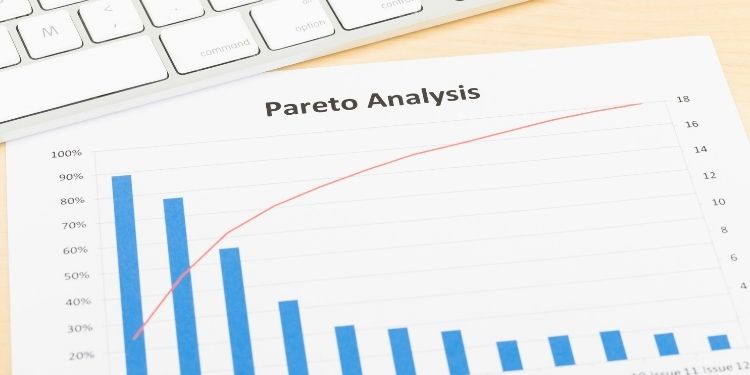The Best Practical Guide to Creating a Pareto Analysis

A Pareto chart is a graph that indicates the frequency of defects and the cumulative impact related to them. In other words, if you want to find out what problems your business is facing and what a process that should be discarded is, then you must take the help of the Pareto analysis or Pareto principle. In this post, we will discuss the best practical guide for creating Pareto analysis.
Now that you know what Pareto analysis is let me tell you that their Pareto analysis is about decreasing inconsistencies like the founder Pareto principle, Vilfredo Pareto, and observed that 80% of the wealth belonged to 20% of the people, which was a huge shock. It continues to even today even in workplaces:
Business– 80% of the work is carried out by 20% of the employees.
Software development– 80% of the logic of a program is run by 20% of code.
Health– 80% of the injuries happen due to 20% harmful hazards.
Crime– 80% of the crime is committed by 20% of the criminals.
It is a big inconsistency ratio of 80/20, in which 80% of the events occur due to 20% of causes and resources.
Table of Contents
ToggleWhen is the right time to use Pareto analysis?
Now that I have mentioned so many examples above, I am sure that you guys must fully understand what Pareto analysis is about. The main objective of Pareto analysis is optimization irrespective of the fact that whatever field it is.
Irrespective of what you guys are trying to optimize, whether it is a business process, workflows, or documentation, you can use Pareto analysis is almost anything.
Also, you can use Pareto analysis in business when you are trying to figure out that what is that one move or process that has the greatest positive or negative impact on the business.
Whenever you are trying to create a Pareto diagram, these are the two things that you must always keep in mind.
The data must be arranged in categories.
The ranking of the categories should matter. The thing is that if it does not matter, then the frequency of your data will not be relevant.
Components of Pareto chart
If you are thinking of creating a Pareto chart, the very first thing that you should do is to try to understand the relationship between the components. A Pareto chart is just like a bar chart, and thus you can easily create two variables you want to find the relationship between as X and y variables.
How to build a Pareto chart?
Let us use a fictional business situation that will help you understand the creation of the Pareto chart better. Say, for example, you want to know what stages throughout the business process are where you face the maximum number of hiccups.
Step 1: Decide the category that you will use as a bottleneck. You can categorize them as say A, B, C, and D.
Step 2: Select which measurement is the best for measuring the grouped categories. It will help you find out the series of occurrences of bottlenecks.
Step 3: think of the timeline you will like to cover in the Pareto chart, like one week or one month.
Step 4: Once you are done with all the three steps mentioned above, you must organize the data in an excel sheet or analysis. You can arrange the data to several occurrences of bottlenecks throughout in descending order.
How to interpret Pareto diagrams?
Now that you know exactly how to create Pareto diagrams, the trickier part interprets the result of the Pareto. Well, it is very simple as I have already told you that Pareto is all about inconsistencies and how a large impact is just due to a small cause, and thus all you have to do is to go through the chart and see the time when a large number of hiccups has occurred.
Then you will automatically figure out the small issues that caused the biggest hiccup during that time slot.
Quality control
Paetro chart analysis is a great way to do some quality control as it helps in tracking down the company’s performance and where exactly you are going wrong. It is the nature of a person that they understand diagrams better.
Pareto does exactly that, visually displays the data so as to make it easier to judge whether the Pareto Principle can be applied to the data. it will help you in better organization and management of the business.
Conclusion:
It is a useful tool, especially for the company’s managers, to find out the problems and fix them. So, you will make the work process more easy and joyful by taking care of the problem. Good Luck!
What do you think of this article? Please share your thoughts with us in the comment section below.
Tony Lanzap, a distinguished astrologer, possesses a profound understanding of celestial patterns. With years of experience, he has honed his skills in interpreting the cosmos to provide insightful guidance. Tony's unique approach blends traditional wisdom with modern insights, making him a sought-after expert in the realm of astrology. His commitment to helping individuals navigate life's journey has earned him acclaim and trust among those seeking cosmic clarity.
Recommended For You
Spread the loveDid you know that nearly 80% of patients use search engines to find healthcare providers? If a medical
Spread the loveBusinesses constantly seek ways to improve their online visibility and attract more customers. Search engine optimization (SEO) is
Spread the loveSearch engine optimization (SEO) has shifted from a nice-to-have feature to a business necessity. In Australia, competition across





